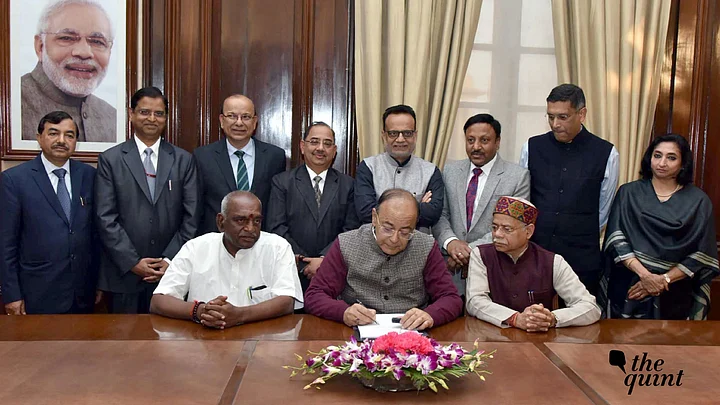The Indian government has let itself off the fiscal hook.
Not only will it not push itself to meet the long-delayed fiscal deficit target of 3 percent of the GDP in 2018-19, it won’t even attempt it the year after. It will stop targeting a revenue deficit from the coming fiscal. And only attempts to bring down its debt-to-GDP ratio to the recommended 40 percent over a six-year period.
At the same time, it will introduce ambitious schemes to its agenda, in particular, the National Healthcare Protection Scheme. The government, without explaining how it intends to fund this, says this will be the largest government funded healthcare programme in the world.
Let’s look at each of these aspects.
Moderate Fiscal Consolidation
According to the medium-term fiscal policy statement put out by the government, the fiscal deficit should be brought down to 3.3 percent in FY19, 3.1 percent in FY20 and 3 percent in FY21. This is the Central government fiscal deficit. States will add to this. Over the next few years, the redemption of UDAY bonds will come up and add to fiscal pressures.
Going by the roadmap provided, it looks like the government will achieve only moderate fiscal consolidation over the next few years.
It has already failed to use the windfall from lower oil prices in the past few years to strengthen its fiscal position, and it is not apparent that it will push itself to do so even in the next few years. In the immediate term, for FY19, there are other issues such as some under-budgeting for oil subsidies, the allocation for which has been left unchanged compared to FY18.
NK Singh Committee’s Recomendations
The second aspect of the medium-term fiscal framework is the government’s decision to accept the NK Singh committee’s recommendations selectively.
For instance, the NK Singh committee had recommended that the fiscal deficit be brought down to 2.5 percent of the GDP by FY23. The government made no mention of attempting to reach that target. It has accepted the recommendation that the debt-to-GDP ratio also be targeted, but again the timelines to meet those targets have been extended. The committee had recommended that the debt-to-GDP ratio be brought down to 60 percent (with a 40 percent target for central government debt) by FY23.
The government says it will only meet this 40 percent target by FY25. To be sure, it has said that definition of what constitutes debt will be widened to include all outstanding liabilities.
Well Defined “Escape and Buoyancy Clauses” and Govt to Stop Targeting Revenue Deficit
Finally, the government said it will “insert” adequately defined “escape and buoyancy clauses” to determine when the targets may be relaxed or tightened as the case may be.
Separately, the government also said it would stop targeting the revenue deficit starting next financial year.
“In a country like India, there is little or no evidence to say that capital expenditure should enjoy pre-eminence,” said the government in its medium term fiscal policy statement.
It may be worth mentioning here that in 2017-18, the government cut capital expenditure by 4.5 percent and saw revenue expenditure increase by 14.8 percent. The government, however, believes that maintenance expenditure in a country like India, which may be counted as revenue expenditure, is as important as capital expenditure.
The slower than expected fiscal consolidation comes at a time when inflation pressures are already on the rise and are likely to test the Monetary Policy Committee’s 4 percent (+/- 2 percent) inflation target.
While this may not immediately push up the timeline over which interest rate hikes are expected, that rate hikes are on the horizon is undeniable. In addition, the government has built in some potentially inflationary elements into policy by assuring a support price which is at least 1.5 times the input cost for the kharif crop. And, of course, global oil prices are on the rise.
All taken together, it’s no surprise that the already beaten down bond markets are seeing red. The new 10-year benchmark bond yield is nudging 7.68 percent. The old benchmark is now close to 7.80 percent. As one bond market expert put it, this year was the first when the Narendra Modi led government was facing headwinds. And it floundered.
(This article was first published on BloombergQuint)
(At The Quint, we question everything. Play an active role in shaping our journalism by becoming a member today.)
